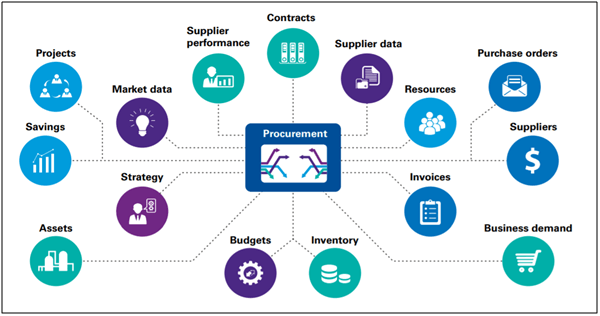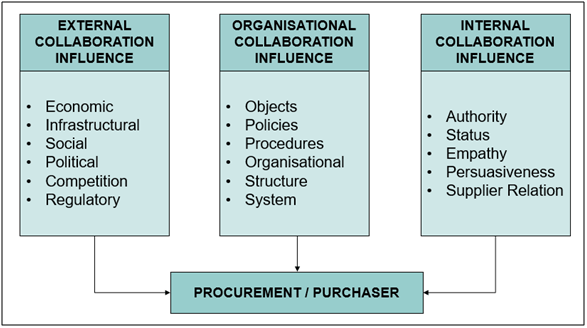With collaborative procurement, we can find valuable partners within treasury, product development, legal, line-of-business, and suppliers, and extend the value of procurement beyond its four walls. Common goals, shared information, linked processes and systems, and above all, mutual understanding, can enhance the value of procurement’s relationships inside and outside of the enterprise. The diagram below shows the links of Procurement with internal and external stakeholders.

Table of Contents
Contemporary Role of Procurement
Today, Procurement continues to undergo significant changes and leading organizations have already integrated the function at the core of strategic considerations, understanding that it will play a central role in transforming the value chain. In order to play this role however, Procurement cannot limit itself to being an independently operated entity. It needs to become an agile function, deeply rooted in the organization’s DNA and involved upstream in cross-functional decisions. The diagram below shows the involvement of Procurement from Internal Office to External Supplier Office.
The Critical Steps of Procurement Collaboration
Procurement leaders must understand the value that lies in collaboration, and they must perceive the required change as one of their main challenges today. In order to develop strategic collaboration in their organization, procurement leaders must recognize that, although they may be an agent of change, they cannot get there on their own. It is crucial for them to on-board senior executives along the way.

Indeed, the first key step in the shift towards strategic collaboration consists of a significant change in the operating model and governance around the Procurement function. As with all topics related to cross-functional changes and governance in general, CEOs are best positioned to lead the transition and to address some of the main challenges, which may include identifying the best way to engage with stakeholders and creating the right conditions to give Procurement a seat in all relevant discussions. Concurrently, procurement leaders need to ensure that their organizations are able to actually step up to the challenge—and, once the opportunity arises, to demonstrate value and strategic thinking.

Implementing Procurement Collaboration
Engage senior management on the Procurement vision and make the change systemic by breaking down silos in order to make the Procurement system visible and appealing to all stakeholders. Build a truly cross-functional system that makes Procurement and business stakeholders “business partners,” equally involved and equally accountable. Translate the overall company’s objectives and equip Procurement leaders with the means to share and implement this vision while deploying the Procurement system. Ensure the new system’s sustainability by making it a part of the company’s DNA and by fostering cross-pollination of talents in and out of Procurement.
Assess and understand fully the company structure, condition and goals.
With the understanding of company goals, combine it with the procurement goals and form a structural process in SOP. On-board your CEO and the management to request for their involvement in the implementation of the procurement requirements structure by using value-based demonstrations and reports. These will further emphasize on the standard of procurement process and its supportive requirement from each department. With smoother processes and collaboration from each department in place, it will be enhancing the company’s overall value-added savings and provide a leaner process. To show the implemented procurement processes proven with result, create a system to continuously tracking and report progress is important.
The diagram below shows the influencing factors for implementing procurement collaboration.

Strategic Collaboration of Procurement

When senior management that includes procurement are aligned, they will create the conditions for success together. Getting to this alignment stage, however, is no easy feat. Most organizations have not yet reached that point. The evolution from “genesis” to “development” is often accomplished in project mode, without transitioning project approaches into a “business as usual” mindset. The difficulty is that, if the shift into “business as usual” does not occur, performance will eventually decline and organizations may actually fall back into the “genesis” stage, thus making sustainability an issue of the utmost importance.
The full content is only visible to SIPMM members
Already a member? Please Login to continue reading.
References
Ardent Partners Research. (2018). “Six Ways for Procurement to Collaborate Inside and Outside of the Enterprise”. Retrieved from: https://cporising.com/2018/07/31/six-ways-to-collaborate-inside-and-outside-of-the-enterprise, accessed 15/12/2019.
Joe Kok Kong Loong, DPSM. (2019). “Essential Technology Application for Public Procurement”. Retrieved from SIPMM: https://publication.sipmm.edu.sg/essential-technology-application-public-procurement, accessed 15/12/2019.
KPMG (2019). “Future of Procurement”. Retrieved from: https://home.kpmg/xx/en/home/services/advisory/management-consulting/optimize-your-sector-operations/future-procurement.html, accessed 15/12/2019.
Oliver Wyman. (2017). “Strategic Collaboration in Procurement”. Retrieved from: https://www.oliverwyman.com/content/dam/oliver-wyman/v2/publications/2017/mar/strategic-collaboration-in-procurement-final2.pdf, accessed 15/12/2019.
PYMNTS (2018). “CPOs Struggle to Prove Themselves a Strategic Asset to The Enterprise”. Retrieved from: https://www.pymnts.com/news/b2b-payments/2018/advanced-chief-procurement-officer-technology-investments-innovation, accessed 15/12/2019.
Zaiton binte Aby Bakar, ADPSM. (2019). “Essential Strategies for Public Procurement Practices”. Retrieved from SIPMM: https://publication.sipmm.edu.sg/essential-strategies-public-procurement-practices, accessed 15/12/2019.

